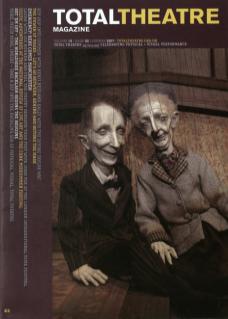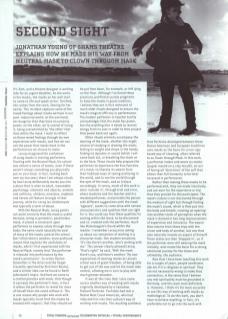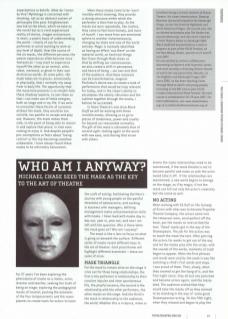It's 3am, and a theatre designer is working late for an urgent deadline. As she works in her studio, the masks on her wall start to come to life and speak to her. Terrified, she rushes from the room, fearing for her sanity. This incident captures some of the mixed feelings about masks we have in our post-industrial world: on the one hand, we recognise that they have an uncanny power; on the other, we're scared of losing it, being overwhelmed by the other that lives within the mask. I want to reflect on those mixed feelings through my own experiences with masks, and how we can use the power that masks have in the performances we choose to make.
Lecoq recognised the usefulness of using masks in training performers. Starting with the Neutral Mask, his school was almost a series of masks, even if those weren't always something you physically put on your head. In fact, looking back over my two years there I am always struck by how Lecoq deliberately moves you into a place that is alien to adult, reasonable psychology: elements and objects, animals and artforms, children, monsters, madmen and heroes all feature strongly in that journey, while for Lecoq les intellectuels was typically a term of abuse.
With the Neutral Mask, Lecoq points out quite correctly that the mask is useful because, being a symmetric, passionless mask, it places a constraint upon performers to express solely through their body; the same could naturally be said of many of the masks used at the school. But I think there's another, more profound reason that explains the usefulness of masks, which I first experienced with the Neutral Mask: namely that the performer is released into performance by the mask's ‘permission'. So writes Declan Donnellan in The Actor and the Target (recently reprinted by Nick Hern Books), and a similar idea can be found in Keith Johnstone's Impro. And here we come to a central paradox with mask: that though it conceals the performer's face, in fact it allows the performer to reveal far more of herself than she could without it. This is one reason why people who work with masks typically insist that the masks be treated with respect; that they should not be put face down, for example, or left lying on the floor.
Although I've heard these practices justified as purely pragmatic to keep the masks in good condition, I believe they are in fact remnants of much older rituals designed to ensure the mask's magical efficacy in performance. The modern performer or teacher tacitly acknowledges that the mask has power, but like anything else it needs to receive energy from its user in order to then project that power back out again.
Other rituals similarly accompany the donning of the mask, whether this might consist of studying or drawing the mask; feeling its weight and shape in the hands; finding its dynamic or sound (which I will come back to); or breathing the mask on to the face. These rituals help prepare the performer to experience the true function of a mask: to liberate its wearer from their habitual ways of seeing and being in the world, and to see the world through the eyes of the mask, and so (re)act accordingly. In Lecoq, much of this work is done 'outside in', through trial and error, where students and the teacher watch a masked performer, and provoke the person with different suggestions until the mask 'appears', seems to come alive with certain characteristics and qualities that are right for it. You could say that these qualities lie waiting within the mask, to be discovered and co-created with the performer, much like Michelangelo's David within the marble. I remember Lecoq once asking us about our sensations of working in a character mask. One student answered, 'It's like there's another, who's working with me.' This answer clearly pleased Lecoq. 'That's right!' He said. 'With the mask there's you, and there's another.' My own experiences of wearing masks at Lecoq's school were of great freedom, of being able to get out of the way and let the mask take control, allowing me in turn to play with much greater abandon.
It was at this time that I also came across another way of working with masks originally developed by a Canadian, Richard Pochinko. Pochinko had met a Native West Coast American, who had inducted him into that culture's way of working with masks. The resulting synthesis that Pochinko developed between these Native American and European traditions uses masks as the basis for a non-ego based way of clowning, often referred to as Clown through Mask. In this work, a performer makes and wears six masks (papier maché on a clay mould), an act of facing all directions of the self that allows their full humanity to be later accessed in performance.
Rather than making these masks to be performed with, they are made intuitively, and are worn for the experience or trip that they provide for the participant. The mask's nature is not discovered through the medium of sight but through finding the mask's sound, which is then put into the body and breath, creating an opening into another realm of perception when the mask is donned in two long improvisations of experience and innocence. The wearer then returns from these trips with the vision and body of another, but one that also naturally reveals an aspect of himself. These states are then 'dropped in', as if the performer were still wearing the mask invisibly, and create the basis for a strong emotional journey for the clown and ultimately, the audience.
Now that I have been teaching this work for a couple of years, people sometimes ask me if it is religious or spiritual. They are not necessarily wrong to make that connection, in the sense that I believe any real spirituality must be grounded in the body, and this work most definitely is. However, I think it's far more accurate to see this way of working with masks as mythological. To do this work, you don't have to believe anything. In fact, it's preferable not to go into the work with expectations or beliefs. What do I mean by this? Mythology is concerned with meaning, not as an abstract system of philosophy (the post-Enlightenment new kid on the block, which we take as the norm) but as a vivid experienced reality of stories, images and persons In short, a poetic basis of understanding the world – clearly of use for any performer or artist wanting to work at any level of depth. Over the course of the six masks, the different personas the wearer experiences often become more fantastical: I may start to experience myself / the other as an animal, alien, robot, mermaid, or ghost in their own distinctive worlds. At some point, the mask takes me to places, emotionally or physically, that I normally shy away from in daily life. The opportunity that the mask here presents is to inhabit fully these shadowy aspects, to own them so that I can make use of these energies, both on stage and in my life. If we were to encounter these facets of ourselves without the mask, they would be too volatile, too painful to accept and play out. However, the mask makes them safe, to the point of being able to remain in and explore that place, in time even coming to enjoy it. And despite people's pre-conceptions or fears about ‘losing control' or the trip becoming somehow unbearable, I have always found these masks to be ultimately benevolent.
When these masks come to be 'worn' invisibly whilst clowning, they provide a strong structure within which the performer is then free to play. As the masks are worn repeatedly, like clothes, they come to feel more homely, and more of myself. I can move from one emotional sphere to another instantaneously, changing my state and view of the world entirely. Magic is normally identified as having an effect 'out there' on the material world, on hard real things. But Clown through Mask shows us that by shifting our consciousness, we also create a shift in perception, and hence of being – our own and that of the audience. And these moments can be transformative, magical. Pochinko's desire was to create a kind of performance that would be truly relevant for today, and in the clown's ability to encompass the utterly ridiculous and the sublime together through the masks, believe he succeeded.
In Sham Theatre's new show Black Stuff we will be working with these invisible masks, allowing us to go to places of tenderness, power and cruelty far beyond our reasonable normality. The gift of the mask is ultimately that of second sight: looking again at the world with new eyes, and sharing that vision with others.


